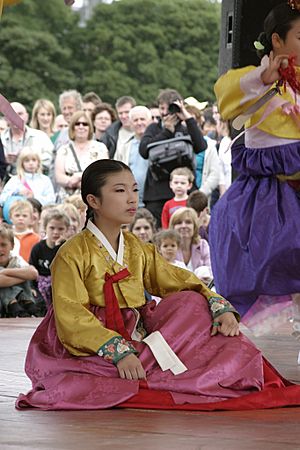Pansori facts for kids
Pansori is a special kind of traditional Korean storytelling through song. It's like a musical play performed by just one singer, called a sorikkun (Korean: 소리꾼). This singer tells a long story using three main parts:
- Chang (song): The main singing parts.
- Aniri (descriptive speech): Spoken parts that explain the story.
- Nurumsae (motion): Movements and gestures the singer uses.
A drummer, called a gosu, plays a barrel drum called a buk (Korean: 북) to help the singer. The word "Pansori" comes from "pan," meaning "a place where many people gather," and "sori," meaning "sound." So, it's a "sound for a gathering place." Pansori is known for being spontaneous. Singers often added their own songs and witty remarks to stories they learned. The term Pansori first appeared in a newspaper called 'Mae-il Shin bo' in 1913.
What Makes Pansori Special?
Pansori is a very skilled art form. Singers need to be highly talented to perform it well. It's also a performing art because one singer acts out all the different characters in a story. Pansori combines music, literature, and acting all in one show.
This art form grew by mixing with other types of Korean traditional music. These include Minyo (folk songs), Mooga (songs shamans sing), Sijo (a type of Korean poetry), Japga (folk music from the Joseon dynasty), and Gasa (another traditional song style). Pansori is unique because it started as popular entertainment for everyone. Over time, it became a respected national art in Korea.
Different Ways to Sing Pansori
Pansori can be performed in two main ways:
- Ba-tang sori (Korean: 바탕소리): This means singing the entire long story from beginning to end.
- Toe-mak sori (Korean: 토막소리) or Ma-di sori (Korean: 마디소리): This means singing only certain parts of a story, usually the most famous or exciting sections.
In the past, if a singer performed only parts of a story, it was just called 'sori'. During the 20th century, many singers mainly performed Toe-mak sori. However, in 1968, a famous male singer named Dong-Jin Park sang the full story of Heungbuga. This performance lasted for five hours! After that, many other singers started trying to perform full Ba-tang sori, even though it takes a lot more effort and skill.
Images for kids
-
A Pansori performance at the Changdeokgung Palace in Seoul, 2013.
See also
Pungmul  In Spanish: Pansori para niños
In Spanish: Pansori para niños






